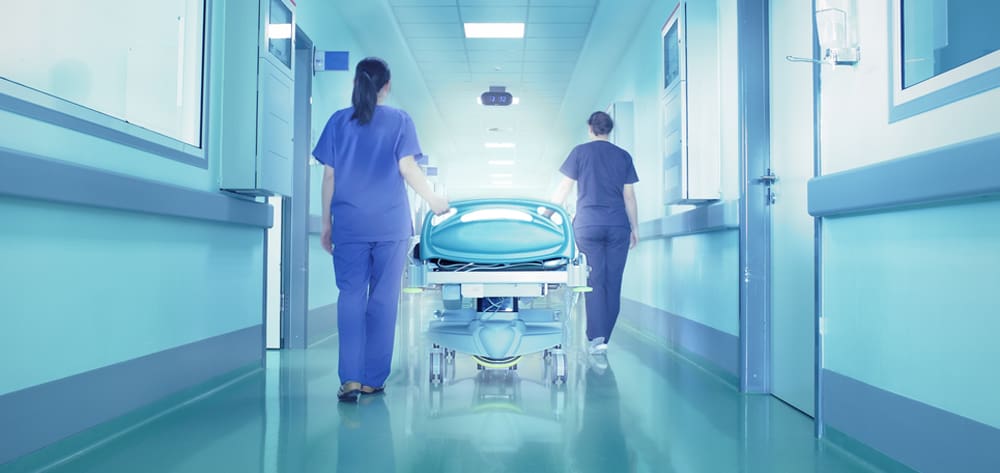FOR DECADES, nurses and other healthcare providers have suffered debilitating musculoskeletal injuries when lifting, transferring, and repositioning patients manually. According to the Bureau of Labor Statistics (BLS), employees in nursing and personal care facilities suffer more than 200,000 patient-handling injuries yearly, and workers’ compensation costs related to such injuries amount to almost $1 billion yearly. In a 2001 survey of nearly 5,000 nurses, 40% said they’d been injured on the job; approximately 60% said they viewed disabling back injuries as one of the biggest health and safety concerns in nursing.
Today, the healthcare industry acknowledges that manual patient handling isn’t safe. Yet relatively few U.S. healthcare facilities have an adequate number of mechanical lifting and repositioning aids. And even where such aids are available, many nurses resist using them—despite irrefutable evidence that manual handling causes injury. Why? Perhaps we’re so devoted to protecting our patients that we don’t focus enough on protecting ourselves.
Ample evidence of injuries
During a typical 8-hour shift, a nurse lifts a cumulative weight of about 1.8 tons. No wonder, then, that evidence-based research corroborates nurses’ aching-back claims. Researchers have analyzed the effects of patient handling on nurses by using surface electrodes that measure our muscle activity and convert it into cumulative spinal compression and shear forces. They’ve assessed our patient-handling methods to predict our peak and cumulative spinal loads. They’ve examined our heart rates and end-of-shift muscle fatigue and appraised our perceptions of low back pain and high demand patient-handling tasks. They’ve even analyzed our trunk motions using a spinal exoskeleton.
To no one’s surprise, they found that patient handling is extremely risky for caregivers. According to the BLS, strains, sprains, and tears caused by overexertion, repetitive motion, and unexpected patient movements make up the largest proportion of patient-handling injuries among nursing, psychiatric, and home health aides.
Unfortunately, researchers can’t capture the profound impact of pain and suffering on injured caregivers. Nor is it a simple process to calculate the economic cost of such injuries—ranging from workers’ compensation to training of replacement nurses—or the impact of these costs on the healthcare system.
Increased bariatric burden
As Americans get heavier, patient handling gets more burdensome. Weight and body proportions in the general population have changed dramatically in the past few decades. The average patient is heavier than ever. According to the National Health and Nutritional Examination Survey, the percentage of U.S. adults considered obese doubled from 15% in the late 1970s to 31% in 2005.
Bariatric patients require multiple caregivers for handling. They may also make handlers more vulnerable to injury by causing the load’s center of gravity to shift and forcing handlers to reach over greater distances and assume awkward postures within confined spaces.
Converting the culture
To make patient handling safer, first we need to change nurses’ attitudes about lifting and promote a safe handling culture. Workers in nearly all other occupations aspire to an injury-free future. Why shouldn’t we? (See Hurtful expectations by clicking on pdf icon.)
How patient-handling techniques affect patient outcomes
Manual patient handling and other bad handling habits can adversely affect patients as well as nurses.
For example:
- A patient may be injured if caregivers lift or tug at her arms or lift her under the shoulders when rolling her or propping her up in bed.
- The patient’s skin may tear or bruise if the nurse uses a gait belt to help move a dependent patient.
- The patient may fall if caregivers neglect to assess her handling requirements and physical abilities.
- Lack of adequate staff or assistive devices to reposition patients can lead to pressure sores (from infrequent repositioning) and skin shear (from linen friction).
Conversely, safe patient handling can enhance the overall quality of patient care and improve clinical outcomes. For instance, most of us know that bringing patients to a standing position periodically and repositioning them regularly yields benefits. These benefits, which are more likely to occur if you use the proper assistive equipment, include:
- improved overall hygiene
- increased comfort and safety
- fall avoidance
- reduction in bruises and skin shearing
- better bowel and bladder functioning
- greater sense of personal dignity
- overall acceleration of rehabilitation results.
Also, once patients are able to ambulate and exercise on a regular basis, they’re less dependent on clinical services and their quality of life improves. In some situations, as when a patient can’t stand or walk unassisted, ambulation devices (such as floor lifts with optional ambulation arms) may be needed to achieve the desired rehabilitation level. Therapeutic benefits of assisted ambulation include a higher fitness level, better range of motion, improved balance, strengthened pelvic muscles, bone density maintenance, decreased urinary tract infections and calculi formation, and improvements in blood pressure, heart rate, and overall self-esteem.
Also, eliminating the lifting and weight-bearing aspects of patient handling enables nurses to more easily perform difficult tasks, such as bathing, without placing stressful loads on the back and joints.
Assessing patient-handling requirements
To determine which patient-handling devices you need or how many caregivers to recruit for assistance, perform a thorough assessment. Start by collecting data about the patient’s:
- weight
- height
- cooperation level
- weight-bearing ability
- bilateral arm strength
- conditions that could affect handling (such as spinal instability, extremely fragile skin, presence of tubes, or severe osteoporosis).
For an assessment tool developed by the Patient Safety Center of the U.S. Department of Veterans Affairs, see Patient handling assessment tool by clicking pdf icon.
Once you’ve completed the assessment, develop a plan of care and document it in the patient’s medical record. The Patient Safety Center has developed patient-handling algorithms that can be incorporated into the plan of care based on the patient’s needs. For a sample algorithm, see Patient transfer algorithm by clicking pdf icon.
Assistive patient-handling devices
To relieve caregiver burden, manufacturers have developed many types of assistive patient-handling devices—some of which are becoming available to nurses on a more consistent basis. Here’s more good news: Some states have passed laws that require hospitals and nursing homes to provide equipment and develop policies to protect caregivers during patient handling.
To help you determine which equipment you’ll need for a particular patient-handling task, we describe basic lifting and repositioning aids below. (See Lifts and slings to lighten your load by clicking on the pdf icon.)
Lateral transfer aids
Lateral transfer aids come in many forms, including air transfer sheets, slide sheets, and repositioning sheets. Applied above the bed linens or under the patient, these friction-reducing devices help minimize the number of nurses required to reposition the patient in bed.
Some lateral transfer aids are tubelike, whereas others act like a pair of slick sheets. In general, they’re used without lifting devices and may take two nurses to apply. Most are applied only during the handling task, but some can be left under the patient for up to a full day.
Mobile full-body floor lifts
Using a mobile full-body floor lift, a single caregiver can meet a wide range of patient-handling requirements safely—for instance, lifting the patient from a bed or even the floor and transferring her to a wheelchair, the bathroom, or other location.
Some mobile lifts also can be used to assist with patient ambulation, gait training, automobile transfers, or other specialized functions. The newest lift-and transfer devices are powered by high-capacity batteries. Some have electrically activated bases that expand or contract to fit around commodes, shower chairs, recliners, or wheelchairs or under beds.
Sit-to-stand lifts
Using a sit-to-stand lift, caregivers can assist a seated patient to a standing position for dressing or undressing, move him to another location, or transfer him between the edge of the bed and a wheelchair. These lifts are particularly helpful with patients too frail or weak to stand without assistance.
Standing assistance aids
An emerging category of nonpowered ergonomic devices, standing assistance aids range from overhead track systems and innovative chair lifts to hybrid standing assistance equipment designed to stabilize and move the patient around the room. As the patient exerts moderate effort toward standing, the device provides a stable leverage mechanism that allows caregivers to transfer the patient easily
between locations. Before using such a device, be sure to evaluate the patient’s functional and weightbearing ability.
Overhead ceiling track systems
Overhead ceiling track systems come in many styles and configurations to support motors and slings; they may feature several types of motors for lifting. Because these systems are convenient and easy to use, nurses and caregivers are more likely to use them than floor lifts.
Slings and accessories
Common types of slings and accessories include:
- slings for seated lifts, which provide leg support
- full-body slings, used for totally dependent patients
- specialty slings—for instance, designed for amputees, pediatric patients, or patients with spinal cord injury.
When using a sling, select the proper size and style based on the patient’s size, weight, and medical condition and the task to be performed. For tasks such as toileting, ambulation, and bathing, consider sling fabric, patient acuity, dependency, and facility layout. With a reusable sling, follow the manufacturer’s laundering and infection control instructions.
Always use slings and accessories made by the manufacturer of the lift device you’re using. Mixing and matching slings, accessories, and lifts from different manufacturers creates an untested, unproven combination—and poses a liability risk should an accident occur.
Components of a safe patient-handling program
In any setting, a safe patient-handling program requires management support, accurate assessment of the unit’s or facility’s needs, availability of appropriate equipment, staff training, caregiver participation, and a means of evaluating results periodically. Below we give specific recommendations for patient-handling programs in healthcare facilities.
Obtaining management support
To purchase the required equipment, mandate staff training, and adopt the policies required for the program, management must support the program.
Recommendation: Obtain management backing to procure financial support and official adoption of lift policies that prohibit manual lifting.
Performing a patient needs assessment
Caregivers must evaluate factors that influence the selection of patient-handling equipment and techniques, including specific characteristics (such as patient size, weight-bearing ability, and special circumstances) and the type of task to be completed.
Recommendation: Facilities may wish to adopt a universally accepted patient needs assessment methodology.
Evaluating equipment requirements
Just as each facility is unique, each functional unit in a facility may have different types of patients and thus require different handling techniques and equipment. For instance, the increased number of bariatric patients and today’s higher patient flow volume call for more lifting devices capable of handling heavier loads. Some units and facilities may need to acquire wheelchairs, beds, and lifts that can handle patients weighing 1,000+ lb. Ideally, these devices should be versatile enough to use for a wide range of tasks, such as assisting patients with ambulation, standing, gait retraining, and repositioning in bed.
Recommendation: Each unit must be assessed individually to ensure a realistic yet optimal equipment mix and inventory based on average patient population and specific clinical requirements.
Staff training
Unless employees are trained in patient needs assessment and the selection and use of assistive equipment, injuries can still occur. A safe handling program must include appropriate training, which should encompass patient functional assessment, selection and use of assistive equipment, and basic equipment maintenance (such as recharging batteries).
Training also improves morale and promotes the cultural changes needed to achieve staff buy-in for the program. By showing an adequate commitment to training, healthcare facilities send employees the message that they believe injury prevention is important.
Recommendation: Facilities should commit to establishing and maintaining a formal ongoing training program and treat it as an investment in staff performance enhancement. They should also consider using peer safety leaders (known as back injury resource nurses, “lift champions,” or “ergo rangers”) on each unit. Research shows this approach is more effective in preventing injuries than conducting unit-specific, episodic training programs.
Getting all caregivers on board
For a safe handling program to succeed, all staff members must adhere to it; partial or optional buy-in is unacceptable. To enhance participation and adherence, leaders should strive to establish a safety-oriented culture that constantly reminds caregivers to practice safe handling within the program’s boundaries. Also, caregivers must be able to report injuries without fear of being blamed. Recommendation: Facilities should adopt a universal and nonpunitive safe handling program and stay committed to it over the long term. (See Resources for safe patient-handling programs by clicking pdf icon.)
Ongoing evaluation of results
The National Institute for Occupational Safety and Health (NIOSH) suggests a simple four-step process for ongoing evaluation of safe patient-handling programs: Form a team, collect data, analyze data, and share the results. After a simple evaluation, facility managers can decide to expand or revise the program as needed.
Recommendation: Obtain the NIOSH publication, “Does it really work? How to evaluate safety and health changes in the workplace” available at www.cdc.gov/niosh/docs/2004-135/.
Let’s take action together
Assistive equipment, proper training, management directives, laws to protect caregivers—all of these things can help reduce worker injuries. But they’re not enough.
To eliminate the scourge of career-ending injuries, each nurse must take action. Help us send a clear message to the healthcare industry that if nurses have the right tools—management support, appropriate equipment, proper training, and nonpunitive policies that restrict manual handling—we will do the right thing. We will practice safe patient handling.
Selected references
American Nurses Association. Nursing World Health & Safety Survey, September 2001. Available at: www.nursingworld.org/surveys/hssurvey.pdf. Accessed October 27, 2006.
deCastro AB, Hagan P, Nelson A. Prioritizing safe patient handling: The American Nurses Association’s Handle with Care Campaign. J Nurs Adm. 2006;36(7/8):363-369.
Nelson A, Baptiste A. Evidence-based practicesfor safe patient handling and movement.OJIN. 2004;9(3). Available at: www.nursingworld.org/ojin/topic25/tpc25_3.htm. Accessed October 27, 2006.
Village J, Frazer M, Cohen M, Leyland A, Park I, Yassi A. Electromyography as a measure of peak and cumulative workload in intermediate care and its relationship to musculoskeletal injury: an exploratory ergonomic study. Appl Ergon. 2005;36: 609-618.
VISN8 Patient Safety Center, U.S. Department of Veterans Affairs. Safe patient handling and movement (algorithms). Available at: www.visn8.med.va.gov/visn8/patientsafetycenter/safePtHandling/default.asp. Accessed October 3, 2006.
Jan DuBose, RN, is Director of Education for Liko, Inc. in Franklin, Mass. Terry Donahue, BSN, RN, COHN-S/CM, is President of Safe Patient Moves, Inc. in Sharon, Mass.
This CE activity was supported by an unrestricted educational grant from Liko, Inc.


















